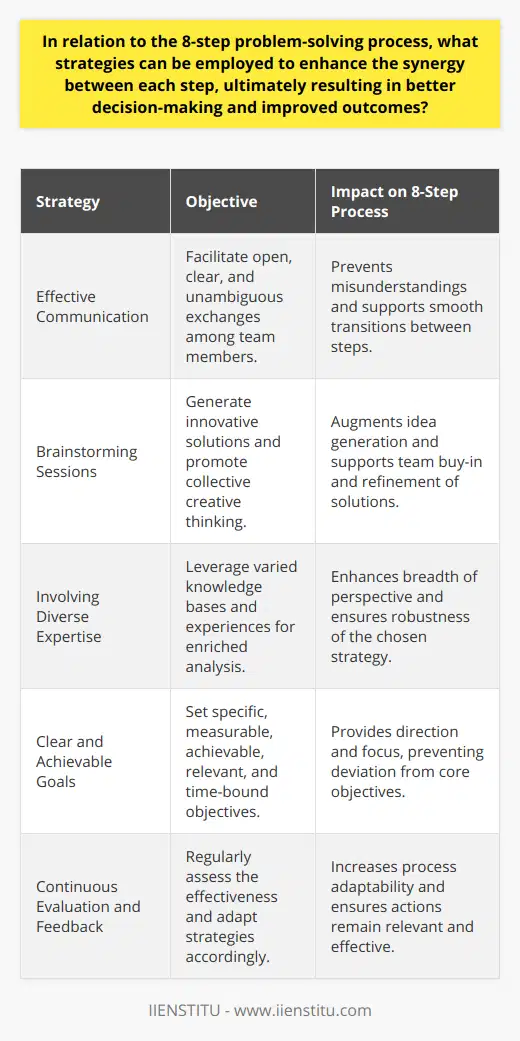
We all face problems every day. Some issues are significant, and some are small, but most can be solved using the same basic steps. By following a simple process of identifying the problem, brainstorming solutions, choosing the best solution, and implementing it, you can solve even the most daunting problem. Let's take a look at each step in more detail.
9 Steps to Solve Any Problem
No problem is too big or too small. Whether you're facing a difficult situation at work or struggling to figure out what to make for dinner, these nine steps can help you solve any problem. Start by taking a deep breath and gathering your information, then use the steps below to guide you to a solution. Problem solved!
Step 1: Identify the Problem
The first step to solving any problem is to identify what, exactly, the problem is. This may seem like a no-brainer, but it's essential to be as specific as possible. For instance, if your car won't start, the problem could be anything from a dead battery to a seized engine. The more specific you can be, the easier it will be to find a solution.
Step 2: Brainstorm Solutions
Once you know what the problem is, it's time to start brainstorming solutions. There is no wrong answer at this stage, so let your mind run wild. For example, if your car doesn't start, possible solutions could include jump-starting the battery or getting a new engine.
Step 3: Choose the Best Solution
Now that you've identified the problem and come up with a few possible solutions, it's time to choose the best one. This will involve considering cost, feasibility, and time commitment. For instance, if your car won't start and you're stranded on the side of the road, calling a tow truck may be your best bet, even though it's not the cheapest option.
Pareto Chart: A Powerful Tool for Data Analysis and Decision-Making
Developing Problem Solving Skills: Lessons from Saint Augustine
Tolerance Analysis: Strategic Approaches, Benefits and Challenges
Step 4: Implement the Solution
After you've chosen the best solution to your problem, it's time to put it into action! This step will vary depending on what kind of problem you're solving. For example, if your car won't start and you've decided to call a tow truck, your implementation plan would involve making the phone call and waiting for help to arrive. But if you're solving a more complex problem at work or in your personal life, an implementation may require developing a detailed plan or taking multiple smaller steps over time.
Step 5: Monitor Progress and Revise as Needed
Once you've implemented your solution, it's essential to monitor its progress. Are things moving along as planned? Are you making the necessary adjustments or changes to achieve your desired outcome? If not, don't be afraid to make revisions or try something new. Again, this is an integral part of the problem-solving process and should be done in conjunction with step 4.
Step 6: Celebrate Success!
Finally, it's time to celebrate your success. Regardless of how big or small your problem is, solving it is an achievement worth celebrating. So take a moment to congratulate yourself on a job well done, and then use what you've learned to tackle the next problem that comes your way.
Step 7: Repeat as Needed
Remember, problem-solving is a process that should be repeated as needed. That means you will undoubtedly face other problems in the future, and that's okay! Just repeat these steps to get through any obstacle that comes your way.
Step 8: Keep Going!
Of course, no problem-solving process is ever truly complete. It's important to remember that these steps are meant to be cyclical and ongoing, so even if you've solved one problem, there will always be more waiting around the corner. But with persistence and a positive outlook, there's no limit to what you can achieve! So keep going and never give up!
Step 9: Ask for Help
If you're struggling with a particular problem or don't know where to start, it's always a good idea to ask for help. Many resources available online and in your community can provide guidance and support as you work through these steps. So be sure to reach out if you need assistance! You'll find that people are often more than happy to lend a hand.
Problem-solving is a process that can be broken down into nine steps. These steps are: identifying the problem, defining the problem, generating possible solutions, evaluating solutions, selecting the best solution, implementing the resolution, and monitoring and modifying the solution if necessary. By following these steps, you can methodically solve any problem you encounter. Join our problem-solving course if you want to learn more about problem-solving and how to use this process effectively.
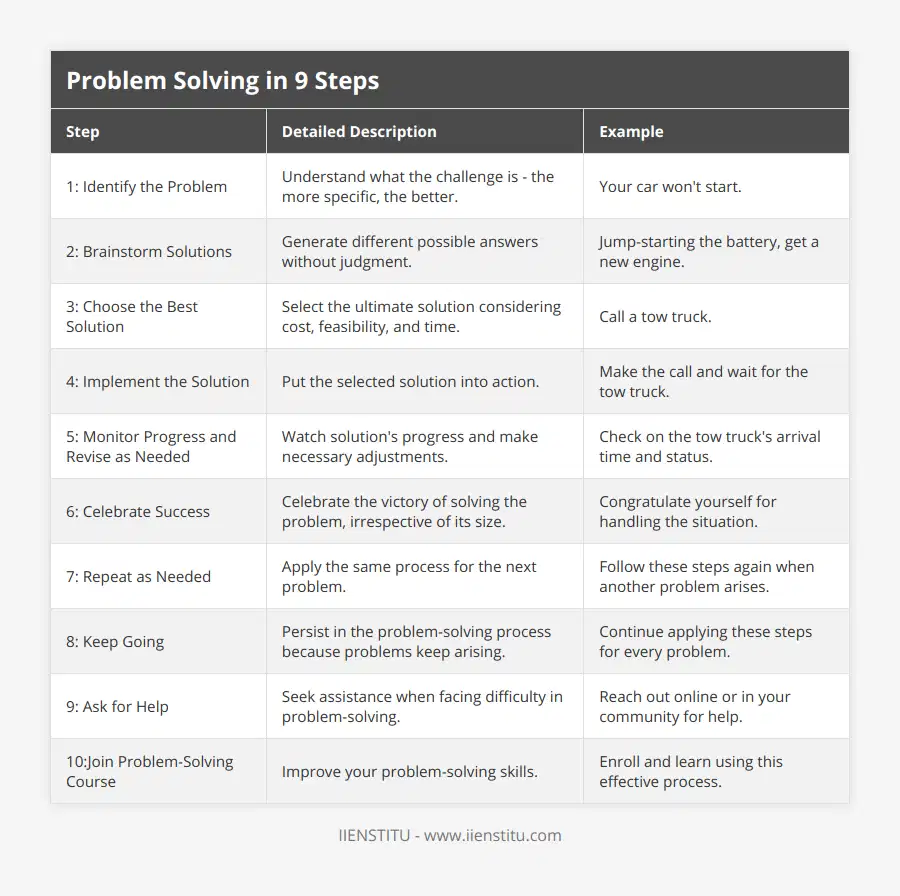
Frequently Asked Questions
What is problem-solving, and what are the steps involved in this process?
Problem-solving is a systematic approach to addressing issues or challenges that we encounter in our lives. This process typically involves breaking down a problem into smaller parts and identifying possible solutions. The steps involved in problem-solving usually include the following:
Identifying the problem.
Defining the problem.
Generating possible solutions.
Evaluating these solutions.
Selecting the best solution.
Implementing the solution.
Monitoring progress.
Making modifications as needed.
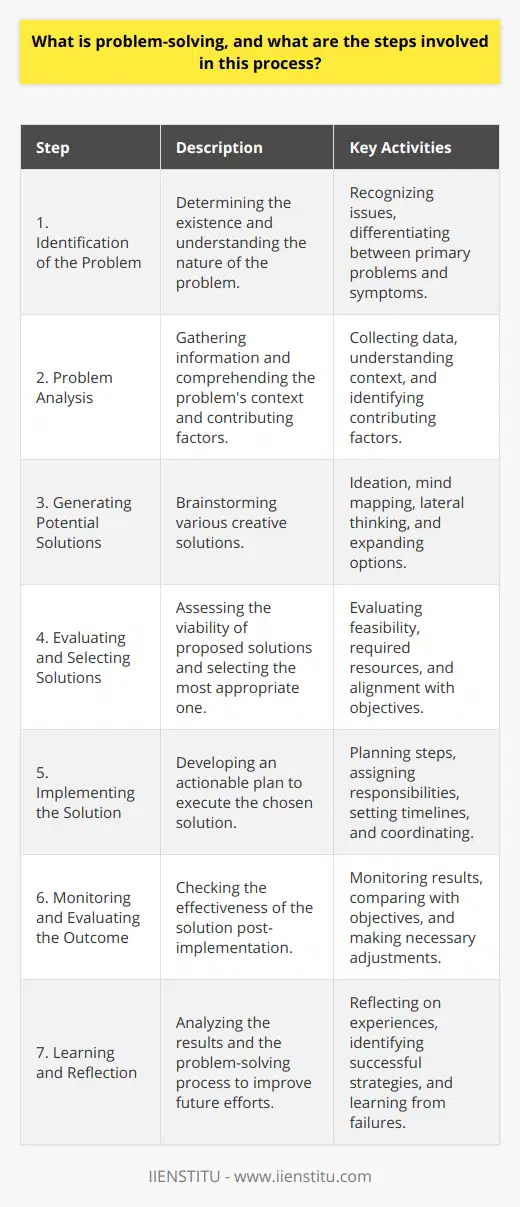
How can you effectively use this process when dealing with different problems?
When dealing with different problems, it is essential to tailor your approach to suit the particular situation. For example, when dealing with complex issues that require a detailed plan or multiple steps, it may be helpful to break these down into smaller components and tackle them one at a time. On the other hand, if you are facing a more urgent problem that requires quick action, it may be better to focus on identifying potential solutions and moving quickly to implement them. Ultimately, the key to practical problem-solving is being able to adapt your approach based on the context and needs of the situation.
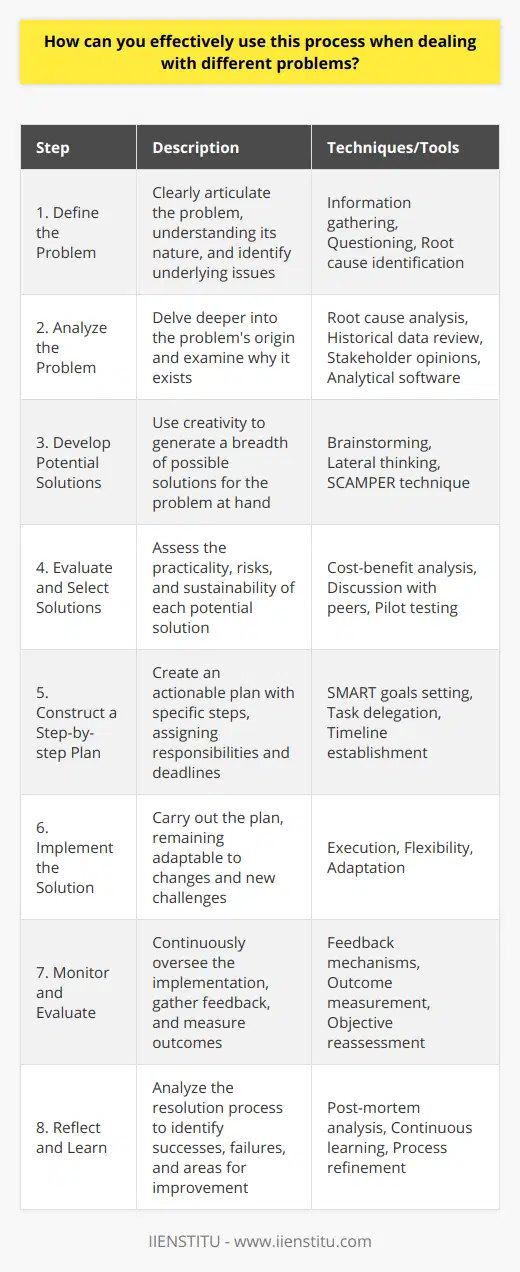
How can you seek help or support when encountering problems?
Many resources are available for help or support when dealing with problems. These include online forums, support groups, counseling services, and professional mentors or coaches. When seeking help or support, it is essential to be honest, and open about your struggles, as this can help you get the guidance and support you need to overcome challenges more effectively. Whether you are dealing with a specific problem or simply looking for advice on improving your problem-solving skills, there are many ways to get the support you need when encountering problems.
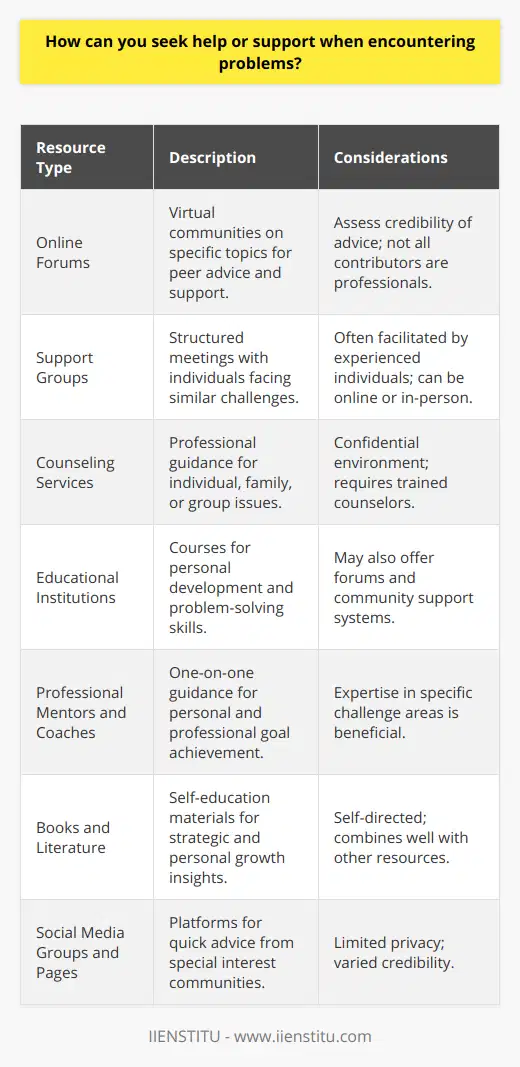
What are the key components of the 8-step problem-solving process, and how do they contribute to effective decision-making?
Key Components of the 8-Step Problem-Solving Process
Understanding the Problem
The 8-step problem-solving process commences with understanding the problem, a vital prerequisite to crafting a targeted solution. By defining the issue, decision-makers can identify both the core question and relevant contextual factors surrounding it.
Gathering Information
The next component, gathering information, equips decision-makers with necessary facts and data about the problem. Researching and analyzing relevant materials ensures a comprehensive base upon which to make informed decisions.
Identifying Root Causes
Subsequently, identifying root causes uncovers the underlying drivers behind the issue at hand, enabling decision-makers to focus on addressing the source rather than merely treating symptoms.
Generating Possible Solutions
With a solid understanding in place, decision-makers can begin generating possible solutions. Considering multiple alternatives fosters creativity and enhances the likelihood of finding a potent resolution.
Evaluating Alternatives
In conjunction, evaluating alternatives involves assessing the feasibility, benefits, and drawbacks of each solution. This measured analysis promotes the thoughtful selection of the best course of action.
Creating an Action Plan
Once a choice is made, creating an action plan outlines the necessary steps to implement the chosen solution. This structured roadmap delineates responsibilities, resources, and a timeline for execution.
Implementing the Solution
The penultimate component, implementing the solution, brings the action plan to life. Decision-makers must oversee and execute the plan, navigating unforeseen challenges and adapting as needed.
Monitoring Progress and Learning
Finally, the problem-solving process concludes with monitoring progress and learning. By reviewing outcomes and assessing results, decision-makers can better understand the impact of their solution and identify areas for improvement in future endeavors.
Ultimately, the 8-step problem-solving process offers a systematic and comprehensive framework that guides effective decision-making. By thoroughly understanding the issue, gathering pertinent data, identifying root causes, considering diverse solutions, evaluating alternatives, devising an action plan, implementing the solution, and monitoring progress, decision-makers are better equipped to resolve complex problems and make informed choices.
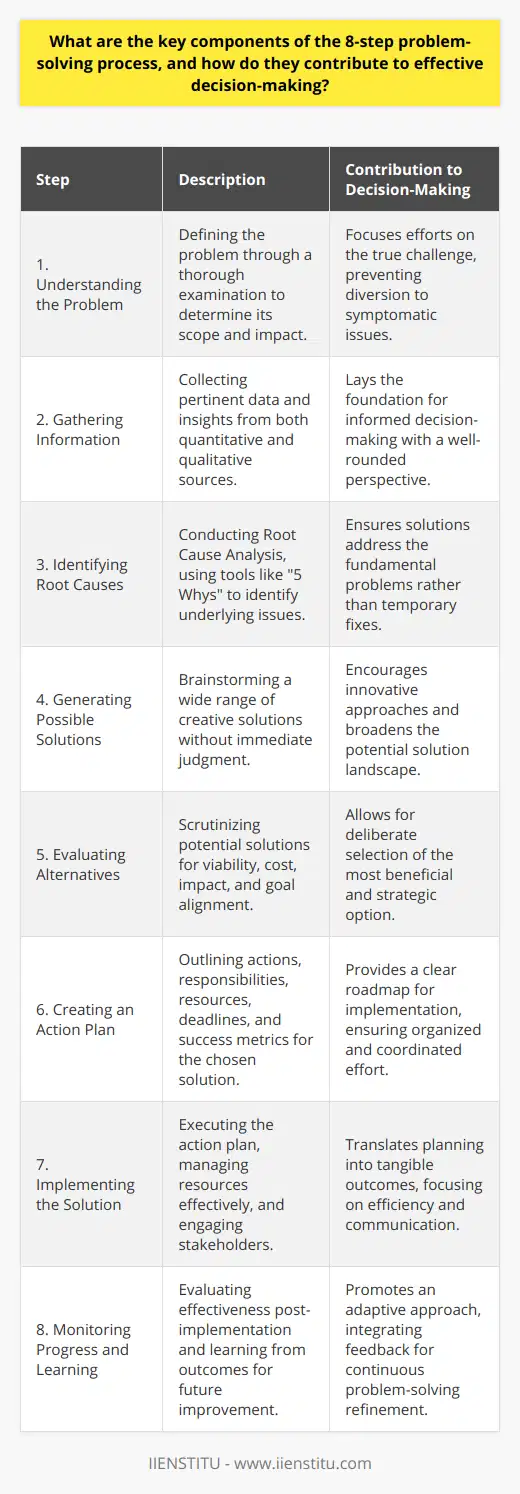
Can the 10-step problem-solving method be applied universally to various disciplines and industries, or are there limitations to its effectiveness?
Universality of the 10-Step Method
The 10-step problem-solving method is a structured approach designed to tackle complex issues systematically. While it is valuable in several disciplines and industries, it may not be universally applicable due to certain limitations.
Discipline-Specific Adaptations
Some disciplines, such as mathematics or engineering, require specific problem-solving techniques that the 10-step method may not address. In these cases, adapting the 10-step method to discipline-specific requirements can ensure its effectiveness.
Industry-Specific Constraints
In industries such as healthcare or finance, time-sensitive issues impact the feasibility of applying the 10-step method. Fast-paced settings may necessitate quicker, specialized approaches that might focus on more urgent steps.
Reliance on Subject Matter Expertise
The 10-step method requires subject matter expertise for accurate problem identification and solution development. However, in situations where expertise is limited, the method may reach its effectiveness threshold, necessitating the integration of additional support to enhance results.
Complexity of the Problem
The ability of the 10-step method to address highly complex problems depends on the comprehensiveness and interconnectedness of the steps. In such scenarios, the method may require further refinement and augmentation to ensure a thorough and effective solution.
Team Dynamics
The 10-step method thrives on collaborative efforts of diverse teams. However, team dynamics and cultural differences can create barriers to the efficient execution of the method. Acknowledging and addressing these challenges is essential for the method's success.
In conclusion, while the 10-step problem-solving method is beneficial across various disciplines and industries, its universal applicability depends on the acknowledgement and adaptation to the specific requirements and limitations of each case. Contextual integration and flexibility are key factors in harnessing the method's potential to deliver robust and effective solutions.

In the context of the 9-step troubleshooting model, how do steps 1 through 3 and 5 through 9 support the critical process of step 4 in identifying effective solutions to challenging issues?
Significance of Steps in the Troubleshooting Model
Preliminary Investigation: Steps 1-3
The first three steps in the 9-step troubleshooting model play a crucial role in setting the groundwork for identifying effective solutions. Step 1 involves gathering information through interviewing users and conducting thorough research. This aids in comprehending the extent of the problem and acquiring essential insights. In step 2, the process of verifying whether the issue is genuine or perceived is carried out. Distinguishing between actual problems and misunderstandings can save time and resources. Lastly, step 3 necessitates determining whether the issue originates from a single source or multiple sources. It is vital to identify the primary cause of the problem to avoid unnecessary repairs and modifications.
Core Analysis: Step 4
Step 4, which is the identification of potential solutions, is the pivotal process in the troubleshooting model. The outcomes from steps 1 to 3 facilitate a comprehensive understanding of the problem, making it easier to pinpoint possible resolutions. Effective problem-solving relies on accurate and precise analysis of the underlying factors. Step 4's significance lies in its capacity to generate viable alternatives that cater to the unique attributes of the problem at hand.
Testing and Implementation: Steps 5-9
The latter part of the troubleshooting model, steps 5 through 9, directly support and depend on the success of step 4. In step 5, the proposed solutions are critically evaluated to gauge their feasibility, practicality, and effectiveness. This evaluation stems from the list of potential solutions generated in step 4. Step 6 involves selecting the best solution based on the evaluation in the previous step. Consequently, all steps are interconnected and influenced by step 4's outcomes.
Step 7 comprises the implementation of the chosen solution, showcasing how step 4's groundwork determines subsequent progress. The penultimate step 8 focuses on observing and monitoring the results of the implemented solution to ensure it resolves the problem. Finally, step 9 emphasizes the documentation and reflection of the troubleshooting process. This serves as a valuable learning experience for future endeavors.
Conclusion
To conclude, steps 1-3 and 5-9 of the troubleshooting model are instrumental in upholding the importance of step 4's central process. These steps influence the critical analysis, implementation, and evaluation of effective resolutions to challenging issues.
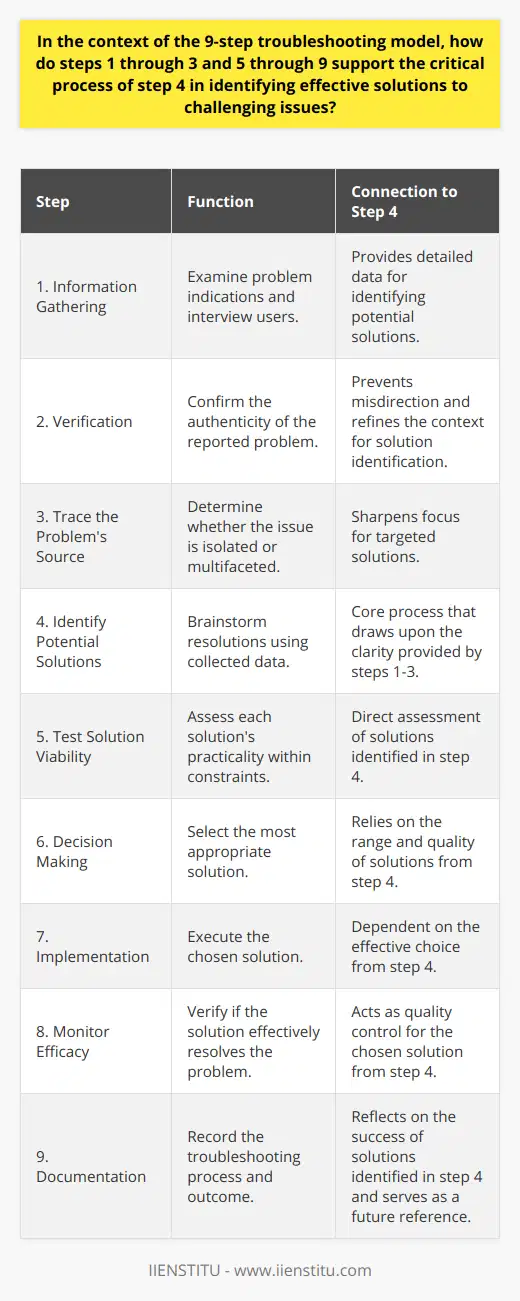
What are the main differences and similarities between the 8-step, 9-step, and 10-step problem-solving processes, and how can one determine the most appropriate method for a given situation?
Overview of Problem-Solving Processes
The primary differences and similarities between the 8-step, 9-step, and 10-step problem-solving processes lie in their complexity, components, and application. Determining the most appropriate method for a given situation depends on the nature and scope of the problem, as well as the resources available to address it.
Key Components and Structure
All three problem-solving processes share the fundamental components of problem identification, analysis, solution generation, and implementation. The 8-step process, being the simplest and most compact, focuses on swiftly identifying the problem, generating a range of solutions, and deciding on the most appropriate one. The 9-step process adds an additional step of critically examining the impact and feasibility of the chosen solution, while the 10-step process further elaborates by emphasizing the planning and evaluation of the chosen solution, as well as continuous improvement.
Applying the Processes to Different Situations
Determining the most suitable problem-solving process for a particular scenario is chiefly influenced by the complexity and urgency of the problem at hand. The 8-step process offers a streamlined approach, well-suited to handling relatively simple and urgent matters that require quick resolution. In contrast, the 9-step and 10-step processes are apt for more complex and intricate problems that necessitate thorough analysis, evaluation, and a structured approach to guarantee successful implementation.
Considering Available Resources
Analysts must carefully weigh the time and resource constraints when selecting the problem-solving process that would best serve their needs. The 8-step process, due to its simplicity, typically demands fewer resources and shorter timeframes for completion. Conversely, the 9-step and 10-step processes entail more extensive data collection, analysis, planning, and evaluation, which may require a higher investment of time and resources.
In conclusion, the choice of problem-solving process primarily depends on the nature and complexity of the problem, as well as the resource constraints faced by the analyst. The 8-step process is ideal for simpler, urgent issues, while the 9-step and 10-step processes offer a more comprehensive and structured approach for complex problem-solving. Ultimately, selecting the most appropriate method relies on a careful evaluation of the problem's attributes and the resources available to resolve it.

How does the integration of creativity and critical thinking skills influence the effectiveness and efficiency of the problem-solving steps in order?
Integration of Creativity and Critical Thinking
The integration of creativity and critical thinking skills significantly enhances the effectiveness and efficiency of the problem-solving process. Creativity enables individuals to generate diverse and original ideas for resolving issues. On the other hand, critical thinking allows them to evaluate these ideas systematically, assess their feasibility, and select the most effective solution.
Influence on Problem-Solving Steps
Identifying the Problem
By integrating creative thinking, individuals can recognize a broader range of challenges within a given situation. Critical thinking, meanwhile, facilitates the prioritization of these challenges, helping to determine the most pressing problem to be addressed.
Analyzing the Problem
The combination of creativity and critical thinking allows for a comprehensive analysis of the problem. Creative thinking encourages the exploration of various perspectives and scenarios, while critical thinking enables the systematic assessment of each perspective to determine its validity and relevance.
Generating Solutions
When generating potential solutions, creativity allows for the consideration of unconventional ideas and novel approaches. Critically assessing these ideas ensures that they withstand logical scrutiny, increasing the likelihood that a suitable solution will be discovered.
Evaluating Alternatives
In evaluating alternative solutions, creativity contributes by encouraging the examination of their potential consequences and implications. Critical thinking, meanwhile, facilitates the weighing of the pros and cons of each alternative to objectively determine the most effective course of action.
Implementing the Solution
Successful integration of creativity and critical thinking also has a positive impact on the implementation phase. Creative thinking helps to develop flexible and adaptable action plans, while critical thinking supports the ongoing monitoring and evaluation of a solution's effectiveness, facilitating adjustments when necessary.
Reviewing the Outcome
Lastly, the combined application of creativity and critical thinking allows for an effective review of the problem-solving process. Creativity fosters the identification of lessons learned and areas for improvement, while critical thinking ensures an objective assessment of the process, promoting continuous growth and development as problem solvers.
In conclusion, the integration of creativity and critical thinking skills enhances the effectiveness and efficiency of the problem-solving steps. Creativity allows for the generation of innovative ideas, while critical thinking enables the systematic assessment and selection of the most effective solution. This combination ultimately leads to more successful and well-rounded problem-solving capabilities.
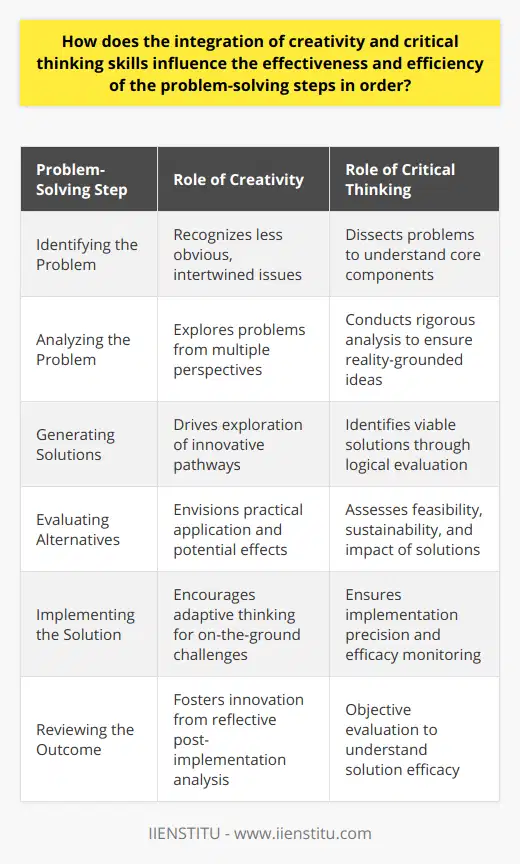
What criteria should be considered when evaluating the success of a problem-solving process, and is there a possibility of modifying these steps to better address individual or organizational needs?
**Criteria for Evaluating Success**
The success of a problem-solving process can be evaluated by considering several essential criteria. These include the accuracy, efficiency, flexibility, and scalability of the proposed solution. Accuracy refers to the extent to which the solution addresses the problem at hand and meets the desired outcomes. Efficiency considers the time, resources, and efforts required to implement the solution, while flexibility addresses the adaptability of the proposed solution to accommodate changes and unforeseen circumstances. Scalability is an essential criterion, as it measures the potential for the solution to be expanded to address larger or more complex issues.
**Possible Modifications for Individual or Organizational Needs**
Modifying the problem-solving process to better address individual or organizational needs is not only possible but also crucial for enhancing its overall effectiveness. Tailoring the process to the unique requirements of individuals or organizations can involve customizing the methodologies employed, developing context-specific performance metrics, adjusting timeframes, and incorporating stakeholder feedback. By making these modifications, individuals and organizations can reap the full benefits of the problem-solving process while ensuring that the limited resources at their disposal are utilized optimally.
**Incorporating Stakeholder Feedback**
A key aspect of customizing the problem-solving process is incorporating stakeholder feedback throughout the process. Stakeholder inputs should inform the problem identification stage and the development of context-specific performance metrics. Furthermore, stakeholder feedback on proposed solutions can help refine the process, focusing on areas that may benefit from further development or improvement. In this manner, the problem-solving process can be enriched by diverse perspectives and rendered more inclusive in nature, potentially enhancing the likelihood of the proposed solution's success.
**Adapting Methodologies**
An effective problem-solving process should be open to adaptation and modification based on the unique characteristics of the problem and the environment in which it is being addressed. By employing methodologies that take into account the domain-specific constraints and affordances, the problem-solving process can be better calibrated to yield optimal results. This implies a greater willingness to experiment with alternative or novel methods of enquiry and employing diverse modes of reasoning. Consequently, adopting a flexible and adaptable mindset toward problem-solving can play a pivotal role in nurturing creativity and resourcefulness in addressing complex, real-world problems.
In conclusion, evaluating the success of a problem-solving process involves considering essential criteria such as accuracy, efficiency, flexibility, and scalability. Modifying the process to better address individual or organizational needs can enhance the overall effectiveness of the problem-solving endeavor. Adaptations may include employing context-specific methodologies, developing tailored performance metrics, obtaining stakeholder input, and adjusting timeframes, ultimately fostering greater resource optimization and a higher likelihood of success.

What are the essential components of the 10 steps of problem-solving, and how do they collectively contribute to a comprehensive understanding and resolution of complex issues?
Essential Components of the 10 Steps of Problem-Solving
Identification of the Problem
The first step in problem-solving involves identifying and defining the issue at hand. By understanding its limitations and effects, one can establish a context for approaching logical solutions.
Break Down the Complex Issue
Next, deconstruct the complex problem into manageable sub-problems. By systematically addressing these smaller components, the overall difficulty becomes more comprehensible and solvable.
Establish Criteria
Establish objective criteria for evaluating possible solutions. This helps to maintain consistency in decision-making and actively consider options that align with the problem's context.
Generate Alternatives
Explore various potential solutions to the problem. The brainstorming process encourages creativity and out-of-the-box thinking, increasing the chances of finding effective solutions.
Evaluate Alternatives
Assess the merits of each alternative solution based on the established criteria. This step enforces objective analysis and enables comparison among potential solutions based on their suitability for addressing the issue.
Make a Decision
After assessing the available alternatives, select the most suitable and practical solution. This choice should maximize benefits while minimizing potential drawbacks and consequences.
Plan the Implementation
Develop a detailed plan for implementing the chosen solution. This includes identifying resources, setting milestones, and determining responsibilities and deadlines.
Execute the Plan
Put the plan into action and monitor its progress. Effective execution requires timely and appropriate resource allocation, followed by coordinated efforts to ensure alignment with overall goals.
Monitor and Evaluate
Regularly evaluate the implemented solution's effectiveness while monitoring its progress. This step ensures the desired outcome is being achieved and allows for continuous improvement throughout the problem-solving process.
Refine the Solution
Finally, adjust and fine-tune the implemented solution based on the evaluation outcomes. This iterative process promotes continuous learning, ensuring that the best possible solution is realized.
In conclusion, the 10 steps of problem-solving provide a structured approach to tackling complex issues by breaking them down, considering diverse perspectives, and implementing well-planned solutions. The process promotes critical thinking and collaboration, contributing to a comprehensive understanding and resolution of the problem at hand.

How does the 9-step problem-solving model compare to other models in terms of flexibility, applicability, and precision in addressing various challenges?
Comparing Flexibility
The 9-step problem-solving model has the advantage in terms of flexibility when compared to other models. This model allows for a comprehensive approach to address various challenges, enabling users to adapt and modify the steps according to the needs of the particular situation. Unlike some rigid methodologies, the 9-step model encourages users to think critically and creatively throughout the problem-solving process.
Applicability Across Contexts
When examining applicability, the 9-step model demonstrates its ability to be relevant and applicable across a diverse range of situations. Because this model encompasses a wide range of techniques and tools, it can be employed across multiple disciplines, industries, and challenges. Its adaptable and multifaceted nature ensures that, regardless of the specific problem at hand, users can apply the model to find the most suitable path to resolution. This broad applicability contrasts with other models that might specialize in specific contexts or disciplines but lack versatility in addressing various challenges.
Precision and Effectiveness
Lastly, the precision and effectiveness of the 9-step problem-solving model sets it apart from alternative models. Due to its comprehensive approach, the model provides a thorough understanding of the problem, establishing precise criteria and objectives to guide decision-making. This ensures that solutions are not only well-considered but also well-executed, increasing the effectiveness of the problem-solving process. While other models may have quicker or simpler processes, they can often lack the depth and granularity required for precise and accurate decision-making.
In conclusion, the 9-step problem-solving model holds several advantages over less flexible, less applicable, and less precise models. Its adaptability, broad applicability, and thoroughness make it a robust choice for tackling diverse challenges across numerous disciplines, ultimately increasing overall success in resolving problems.
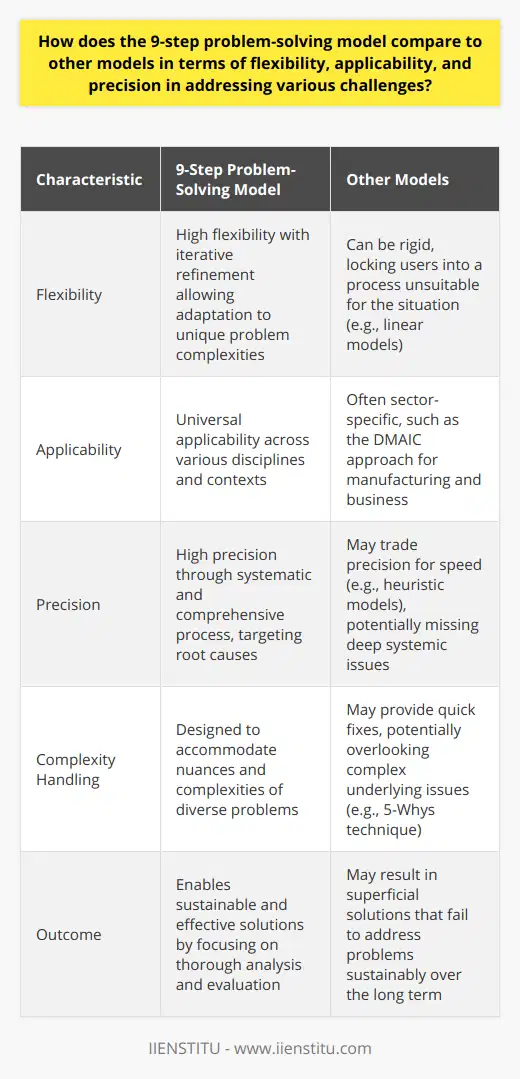
In relation to the 8-step problem-solving process, what strategies can be employed to enhance the synergy between each step, ultimately resulting in better decision-making and improved outcomes?
Enhancing Synergy in the 8-Step Process
To improve decision-making and outcomes within the 8-step problem-solving process, specific strategies can be applied to promote synergy between each step. These strategies include communication, brainstorming, collaboration, and evaluation.
Effective Communication
Highlighting the importance of clear, open, and concise communication as a crucial strategy, it’s essential for enhancing synergy among team members in the decision-making process. Ensuring that information is accurately understood and interpreted by all individuals enables the flow of ideas and fosters meaningful discussions.
Brainstorming Sessions
Organizing regular brainstorming sessions enables team members to share various ideas freely and stimulate creative thinking. This collaborative approach encourages new perspectives to emerge, tapping into the collective knowledge pool and enriching the overall problem-solving process.
Involving Diverse Expertise
Incorporating a diverse team of individuals with various skillsets, backgrounds, and experiences adds perspective and expertise to the problem-solving process. This diversity enhances synergy between steps by enabling a comprehensive understanding of different aspects of the problem and fostering innovative solutions.
Clear and Achievable Goals
Establishing clear and achievable goals at the beginning of the 8-step process helps maintain focus throughout each stage. This strategy ensures that all efforts remain in alignment and contribute to the ultimate objective. Regular progress updates and open discussions help to maintain momentum and engagement.
Evaluation and Feedback
Lastly, continually evaluating the problem-solving process is crucial for refining strategies and gaining valuable insights. Implementing a feedback loop between each step of the process increases synergy by catching potential roadblocks early and ensuring that issues are addressed promptly.
In conclusion, enhancing synergy within the 8-step problem-solving process can be achieved through clear communication, brainstorming, involving diverse expertise, setting clear goals, and consistent evaluation. Implementing these strategies ultimately results in better decision-making and improved outcomes.
